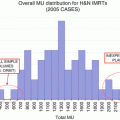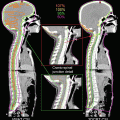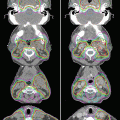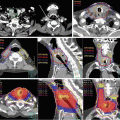Study
Year
Ce/Hp
5ySR (%)
Morbidity n (%)
Hospital mortality n (%)
Wei et al. [5]
1998
32/37
24
34(49)
6(9)
Triboulet et al. [6]
2001
78/131
24
42(33.1)
10(4.8)
Wang et al. [7]
2006
15/26
31.5
19(46.3)
4(9.8)
Daiko et al. [8]
2007
74/0
33
25(34 %)
3(4 %)
Tong et al. [9]
2011
43/25
37.6(2y)
5(7.1)
Daiko et al. [8] reported that the first recurrence after surgery was mostly locoregional (82 %) and that the rate of distant metastasis was 14 %. They reported that pathological staging, namely, pT, pN, pM1 distant lymph node metastases, lymphatic invasion, and extracapsular invasion, was prognostic factors identified using univariate analysis. Triboulet et al. [6] reported that the pT3 and pT4 histopathological stages were poor prognostic factors in surgical cases of cervical esophageal cancer. Thus, surgery can be applied for locally advanced disease, but outcome is not satisfactory and a worse quality of life (QOL) is a problem.
15.4 Radiation Therapy
15.4.1 Results of Radiation Therapy
Radiation therapy for cervical esophageal cancer has a major positive impact on the QOL of patients as a result of the preservation of the larynx and esophagus [10]. Therefore, radiation therapy is often preferred over surgery in the clinic. The optimal radiation dose and fractionation have not yet been established; a wide range (50–70 Gy) of prescribed doses regarding the doses, which are used for either thoracic esophageal cancer or head and neck cancer, have been reported [9, 11–19]. Although no large prospective trials have been carried out because of the small number of cases involved, the outcome of radiation therapy has been reported in several studies (Table 15.2). Burmeister et al. [13] reported on 34 patients (Stage I, 4; Stage II, 27; Stage III, 3) treated using chemoradiation therapy at a total radiation dose of 61.2 Gy (mean dose); 3- and 5-year overall survival rates were 60 % and 55 %, respectively. Yamada et al. [14] reported on 27 patients (UICC 1997 Stage I, 5; Stage II, 6; Stage III, 12; Stage IV, 4) treated using definitive radiation therapy at a mean total dose of 66 Gy; both 3- and 5-year overall survival rates were 37.9 %. Uno et al. [18] reported on 21 patients (UICC 1997 Stage I, 1; Stage II, 5; Stage III, 8; Stage IV, 7) treated using definitive radiation therapy (median dose 64 Gy), and the 2- and 5-year overall survival rates were 41 % and 27 %, respectively. For 11 patients who did not have grade T4 tumors, the 5-year overall survival rate was 41 %. Gkika et al. [21] reported on 55 patients (UICC 1992 Stage II, 20; Stage III, 35) treated by means of definitive chemoradiation therapy (median dose 60 [range, 50–70] Gy). Overall survival rates at 2, 3, 5, and 10 years were 35 %, 29 %, 25 %, and 10 %, respectively. Although the above reports represent only a small number of retrospective studies involving differences in doses and chemotherapy regimens, the results of radiation therapy have been promising. A few studies regarding treatment results using intensity-modulated radiation therapy (IMRT) have been used as a basis for the treatment of cervical esophageal cancer [22]. Huang et al. [16] reported that patients treated from 2001 at a total radiation dose of 70 Gy delivered in 35 fractions, using either three-dimensional conformal radiation therapy (3D CRT) or IMRT together with concurrent cisplatin, achieved a 2-year overall survival rate of 32 %. Wang et al. [20] reported on the initial experience of seven patients treated with IMRT at the MD Anderson Cancer Center, at total doses of 59.4–66 Gy (median 64.8 Gy) given in combination with concurrent chemotherapy. Several preliminary studies regarding IMRT for both cervical and upper thoracic esophageal cancer have also been published [22, 23]. Overall, whether or not better coverage of the planning target volume (PTV) by IMRT leads to an improvement in local tumor control and patient survival is unknown and a prospective study is needed.
Table 15.2
Outcomes of patients treated using radiation therapy
Study | Year | n | Dose (Gy) | CCRT (%) | IMRT (%) | LRC (%) | 2y-OS (%) | 5y-OS (%) |
|---|---|---|---|---|---|---|---|---|
Stuschke et al. [12] | 1999 | 17 | 60–66 | 100 | 0 | 33(2y) | 24 | NA |
Burmeister et al. [13] | 2000 | 34 | 50.4–65 (mean 61.2) | 100 | 0 | NA | NA | 55 |
Yamada et al. [14] | 2005 | 27 | 44–73.7 (mean 66) | 85.2 | 0 | 13(5y)a | 38 | 38 |
Wang et al. [15] | 2006 | 35b | 24.5–64.8 (median 50.4) | 100 | 0 | 47.7(5y) | NA | 18.6 |
Wang (MDA) [20] | 2006 | 7 | 59.4–66 (median 64.8) | 100 | 100 | NA | NA | NA |
Uno et al. [18] | 2007 | 21 | 60–74 (median 64) | 90 | 0 | NA | 41 | 27 |
Huang et al. [16] | 2008 | 71 | 52 | 37(2y)c | 35 | 18.6 | ||
(29) | 54Gy/20fr. | 45 | 0 | NA | 41 | NA | ||
(42) | 70Gy/35fr. | 57 | Some | NA | 32 | NA | ||
Tong et al. [9] | 2011 | 21 | 60–68 | 100 | 0 | NA | 46.9 | NA |
Cao et al. [17] | 2013 | 115 | 59.4–80 | 30.4 | 73.6 | 68.3(2y)d | 47.6 | NA |








